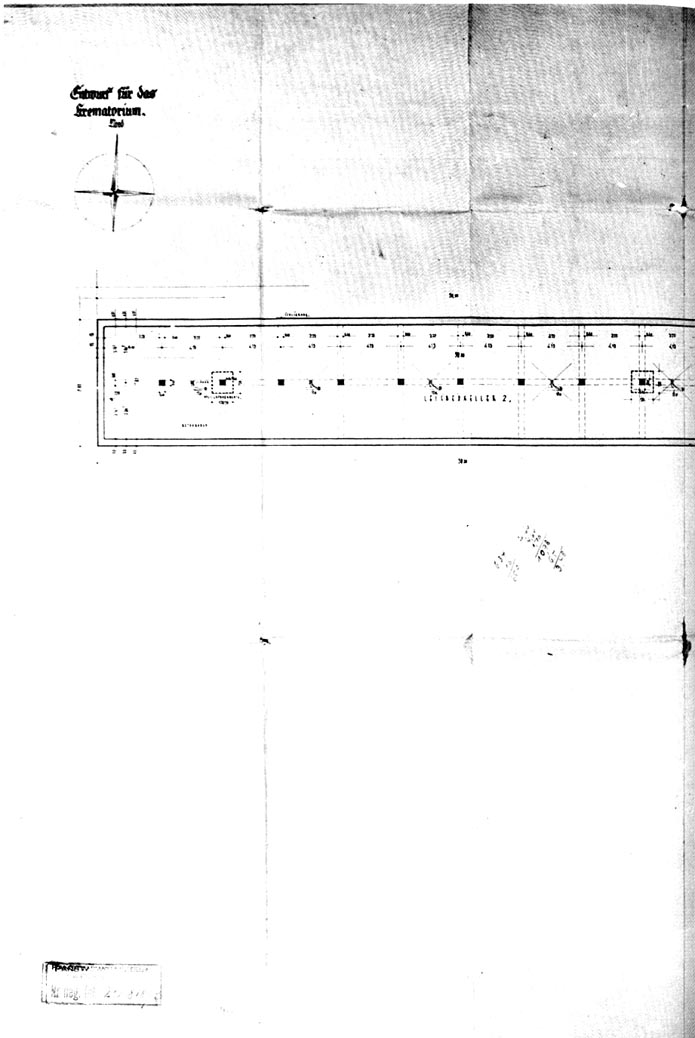| Drawing 932(p) |
 |
|
| BAULEITUNG DRAWING 932 |
The first drawing, 932 (p) [Polish] comes from the PMO Archives, BW 30/01, neg. nos. 17079 and 20818/3
The second drawing, 932 (r) [Russian] comes from the “October Revolution” Central State Archives in Moscow.
Krematorium [Birkenau Krematorium II, BW 30], scale 1:100
Entwurf für das Krematorium / Project for the Krematorium
Schnitte / Cross-sections
Grundriß vom Untergeschoß / Basement plan
Drawn on 23/1/42 by SS Sergeant Ulmer,
checked on 28/1/42 by SS Second Lieutenant Dejaco and
approved on 28/1/42 by SS Captain Bischoff
[The date 7/7/42 followed by unknown initials above the identification block on 932 (p) would appear to be of civilian origin (the Huta civil engineering firm perhaps)] |
Translation of inscriptions:
(from left to right and top to bottom) |
| — |
Betonboden / concrete floor |
| — |
Siphon / Siphon |
| — |
Pfeilerfundamente / Pillar foundation |
| — |
Isolierung / Damp-proofing |
| — |
LEICHENKELLER 2 / CORPSE CELLAR |
| — |
2 Absetzgrube / drainage ditch |
| — |
13 Steigungen / 13 steps |
| — |
GANG / CORRIDOR |
| — |
Zum Kanal / To sewer |
| — |
Entlüftungskanal / air extraction duct |
| — |
LEICHENKELLER 3 / CORPSE CELLAR 3 |
| — |
Rutsche / [Corpse] chute |
| — |
LEICHENKELLER 1 / CORPSE CELLAR 1 |
| — |
SIEHE DECKBLATT ZEICHNUNG NR 1311! /
SEE CORRECTION SHEET DRAWING 1311! |
| — |
VORRAUM / VESTIBULE |
| — |
Aufzug / Corpse lift |
| — |
Entlüftungskanal / air extraction shaft |
| — |
Entlüftungskanal / air extraction duct |
| — |
Nicht unterkellert / Without basement |
| — |
Nach stat. Berechnung / According to static calculations |
| — |
Schornstein / Chimney |
| — |
Rauchkanal / [Underfloor] smoke flue |
| — |
Ofenfundamente / Furnace foundations |
| — |
Kontrollschacht / Inspection manhole |
| — |
Klargrube / Cesspit |
|
| Drawing 932 is now the best known of all the Krematorium II drawings. Widely published by both the traditional historians (Georges Wellers) and the revisionists (Robert Faurisson), it is presented as evidence or counter-evidence, depending on the thesis supported, without any valid comment or serious study. In fact, drawing 932 contains no “criminal traces” indicating the final purpose of Krematorium II, whose apparent “normality” here would seem to support the revisionist argument. |
| Drawing 932 is made up of three parts: |
| — |
In the center, the foundations, with no basements, of the furnace room and the north wing containing the waste incinerator. |
| — |
On the right (east), the foundations, with no basements, of the fuel store and other ancillary rooms; |
| — |
On the left (west, the basement or “cellar” part of the Krematorium, with the corpse chute serving the three underground morgues originally planned. |
The date of 21/l/42 is that of the original version, but cannot be accepted for this version. for the semi basements, Leichenkeller 1 and 2, as shown here could not be built on the site in the main camp for lack of space.
This drawing is therefore most probably a second version of the basement area of the planned Krematorium, redrawn to suit the new site in Birkenau, no doubt in April 1942. The only difference between this and the original version of January 1942 drawn for the main camp would be: |
| 1. |
An increase in the area of the two Leichenkeller originally planned [letter of 22nd October 1941, no. 715?/41 Ho], explicable by the camp originally planned for 10-30,000 prisoners being increased to take a planned 100-150,000 or even more; |
| 2. |
Leichenkeller 1 and 2 now planned as semi-basements instead of full basements, because of the high water table in Birkenau; |
| 3. |
creation of a third underground morgue, Leichenkeller 3. |
| The numbering of the three Leichenkeller, 1, 2, and 3 is not explained in any known German document. Judging by their arrangement around their source of supply, the corpse chute, and the ventilation shown on drawing 932, it is reasonable to suppose that: |
| a) |
Leichenkeller 3 was to be the reception morgue, where the prison numbers of the corpses would be recorded; |
| b) |
Leichenkeller 2 was to be temporary storage for newly arrived and recorded corpses awaiting cremation (delay of 3 or 4 days); |
| c) |
Leichenkeller 1 was to take corpses several days old, beginning to decompose and thus requiring the room to be well-ventilated, to be incinerated as soon as possible. |
| There is nothing on this drawing that indicates the future “special"use of this Krematorium. Quite the contrary, it looks a perfectly “normal”, though very high capacity, incineration facility. The arguments against Krematorium II having been planned from the outset as an instrument of extermination are as follows: |
| 1. |
No access stairway from the exterior to the future undressing (Leichenkeller 2) [this absence is particularly visible on 932 (r), where the Soviets have tried to rectify the defect by adding some steps in the center of its west wall, which is incorrect, the actual location being more to the north]. What is more. the Krematorium was actually built without this stairway [photos neg. nos. 286 and 20995/493 for Krematorium III] which was added later; |
|

